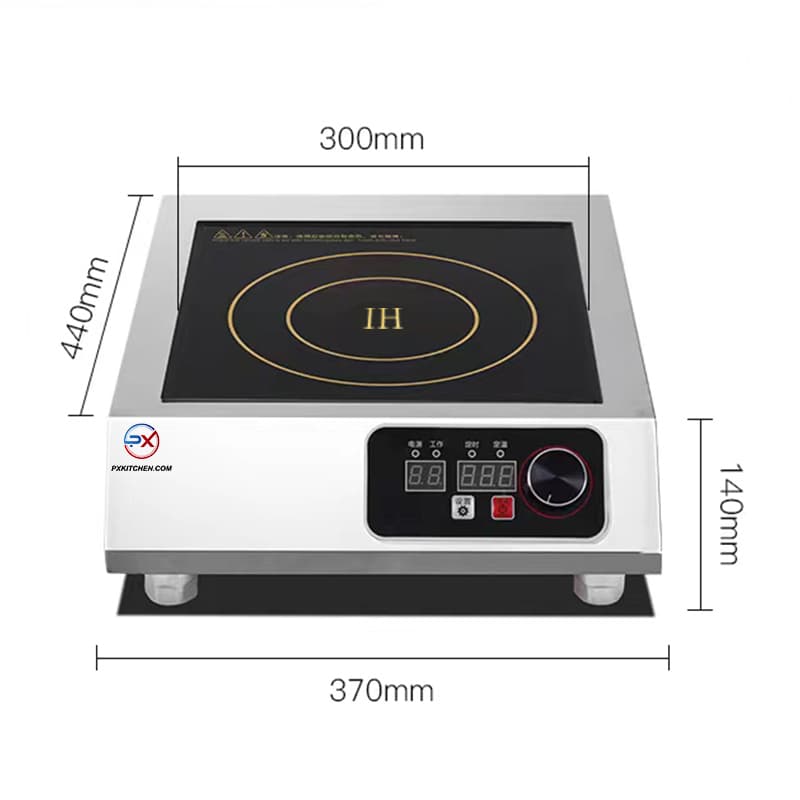Step into the bustling kitchen of a modern restaurant, and you'll likely encounter the graceful hum of commercial induction cookers orchestrating a symphony of culinary creations. At the heart of these sophisticated appliances lies a remarkable fusion of science and innovation, embodied by their intricate components.
Central to the functionality of an induction cooker is the mesmerizing dance of electromagnetic fields. Unlike traditional gas or electric stoves, which rely on direct heat transfer, induction cookers harness the power of electromagnetic energy to generate heat within the cookware itself. This ingenious process begins with the induction coil, a coil of copper wire nestled beneath the sleek surface of the cooktop.
When an electric current flows through the induction coil, it produces a fluctuating magnetic field, which extends upwards through the glass-ceramic surface. Placing a ferromagnetic (magnetic) pot or pan atop the cooktop completes the circuit, causing the magnetic field to induce an electric current within the cookware. This induced current generates heat through a process known as Joule heating, rapidly raising the temperature of the cooking vessel and its contents.
The efficiency of induction cooking is nothing short of extraordinary. Unlike traditional methods, which waste energy by heating the air around the cookware, induction technology delivers heat precisely where it's needed – directly into the base of the pot or pan. This targeted approach not only accelerates the cooking process but also minimizes energy loss, making induction cookers significantly more efficient than their conventional counterparts.
Beyond efficiency, the controlled precision of induction cooking revolutionizes culinary execution. With the ability to adjust temperature settings with unparalleled accuracy, chefs can fine-tune their cooking techniques to achieve optimal results. From delicate sauces requiring gentle warmth to searing meats at blistering temperatures, the versatility of induction technology empowers culinary professionals to elevate their craft to new heights of perfection.
But the magic doesn't stop there. Within the core of an induction cooker lies a labyrinth of heating elements meticulously engineered to deliver consistent and reliable performance. These elements, typically made of high-quality materials such as copper or aluminum, work in tandem with the electromagnetic fields to distribute heat evenly across the cooking surface. Whether you're sautéing, simmering, or stir-frying, each zone of the cooktop radiates with precision-engineered warmth, ensuring uniform cooking results with every dish.
As the culinary landscape continues to evolve, so too do the capabilities of commercial induction cookers. Innovations in heating element design, coupled with advancements in electromagnetic technology, promise even greater efficiency, reliability, and versatility in the kitchen. From bustling restaurant kitchens to discerning home chefs, the allure of induction cooking shines brightly as a beacon of culinary innovation.
The Elegance of Touch Controls and the Promise of Durability
In the realm of commercial induction cookers, elegance meets functionality in the form of intuitive touch controls. Gone are the days of cumbersome knobs and dials – modern induction cookers embrace sleek, minimalist interfaces that respond effortlessly to the gentle caress of a fingertip.
At the forefront of this technological marvel are touch-sensitive control panels, seamlessly integrated into the smooth surface of the cooktop. These panels offer a myriad of options for culinary customization, allowing users to adjust heat settings, set timers, and activate specialized cooking modes with unparalleled ease. Whether you're a seasoned chef navigating the rigors of a busy kitchen or an aspiring home cook exploring the joys of gastronomy, the intuitive nature of touch controls invites you to unleash your culinary creativity with confidence and precision.
But beneath the surface elegance lies a commitment to durability and reliability that sets commercial induction cookers apart. Crafted from robust materials such as tempered glass and stainless steel, these appliances are engineered to withstand the rigors of commercial kitchen environments without compromising on performance or aesthetics. Resilient against scratches, stains, and heat damage, the sleek exteriors of induction cookers exude a timeless elegance that remains unmarred by the demands of daily use.
Beyond their exterior resilience, commercial induction cookers boast an inherent durability that transcends conventional cooking appliances. With fewer moving parts than traditional stoves and ovens, induction cookers are less prone to mechanical wear and tear, resulting in extended lifespans and reduced maintenance requirements. This inherent reliability not only minimizes downtime in busy kitchens but also offers long-term cost savings and peace of mind for restaurateurs and home chefs alike.
Moreover, the environmental benefits of induction cooking cannot be overstated. By harnessing electromagnetic energy to generate heat, induction cookers produce no harmful emissions or byproducts, making them a sustainable choice for eco-conscious consumers. With a focus on energy efficiency and resource conservation, induction technology aligns seamlessly with the growing movement towards environmentally responsible culinary practices.
In conclusion, the allure of commercial induction cookers lies not only in their sleek design and intuitive functionality but also in the remarkable ingenuity of their essential components. From the mesmerizing interplay of electromagnetic fields to the refined elegance of touch controls, each facet of these culinary marvels embodies a commitment to efficiency, precision, and durability. As the culinary landscape continues to evolve, the enduring appeal of induction cooking stands as a testament to the timeless marriage of innovation and tradition in the art of gastronomy from PXKITCHEN.
